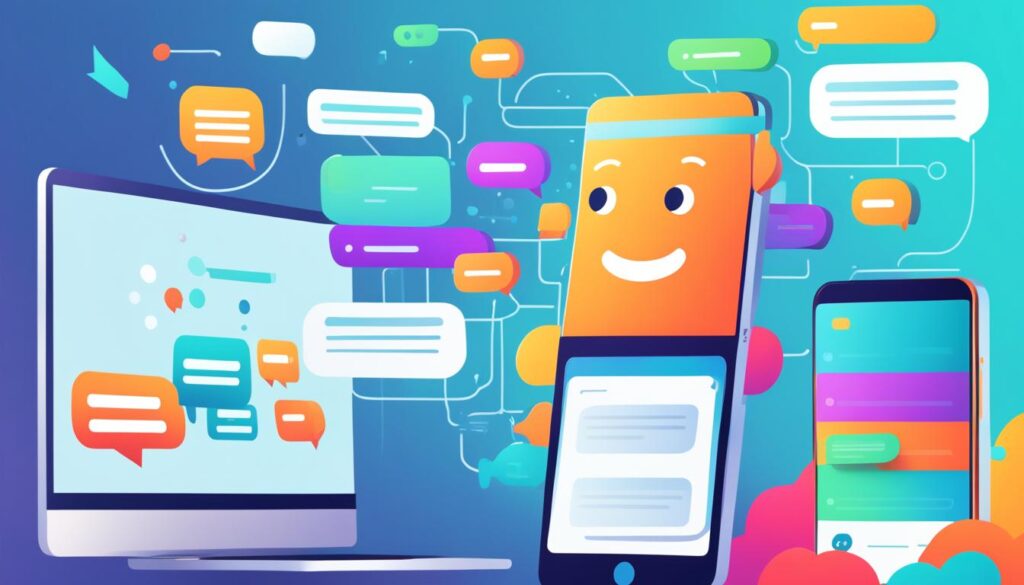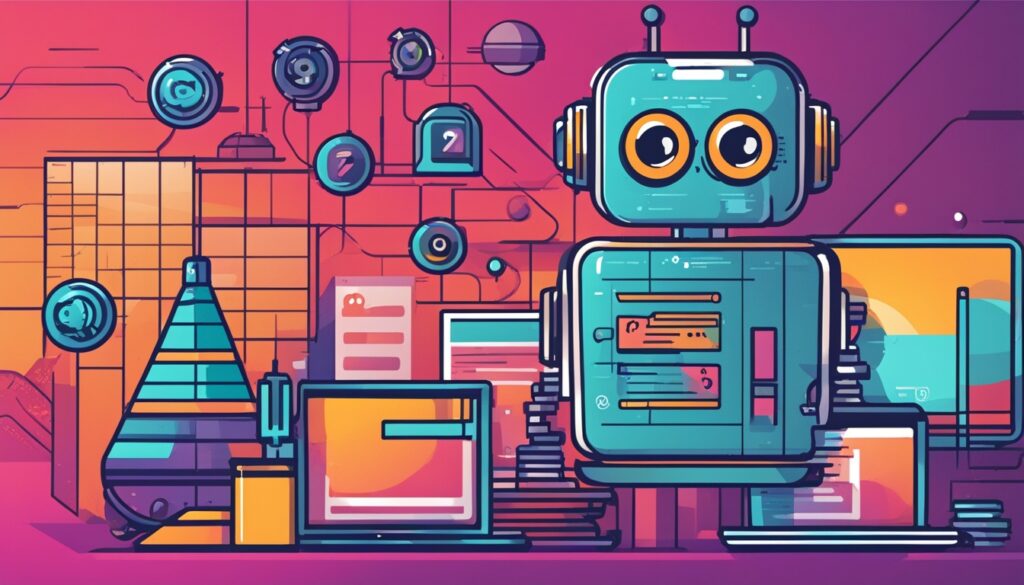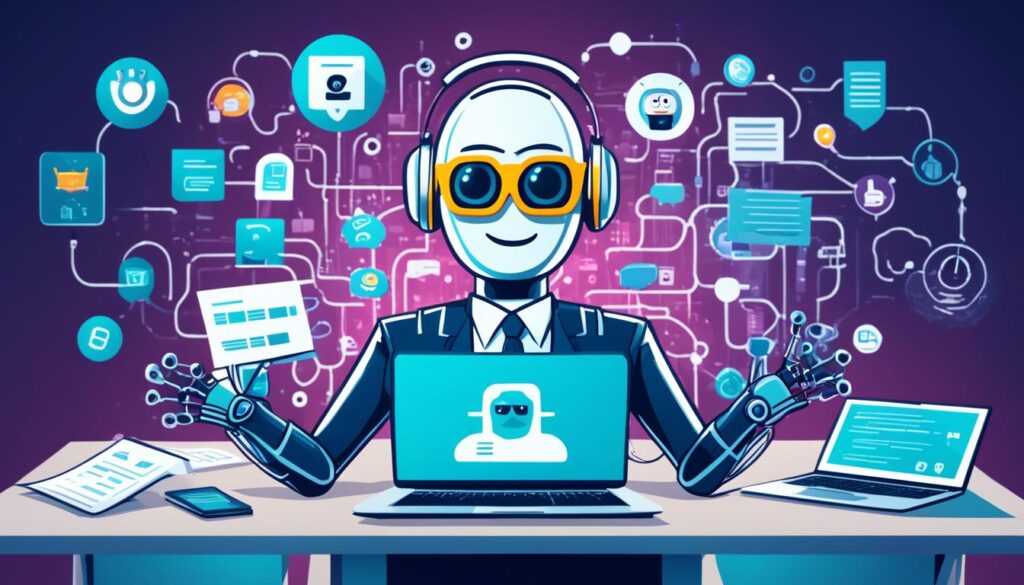In today’s fast-paced business world, companies are always looking for new ways to improve customer service and grow. Chatbots for business are a key innovation that can change the game. They can make customer service better, increase efficiency, and help your business succeed more.
Key Takeaways
- Discover how conversational AI and virtual assistants can transform your customer service and engagement.
- Explore the benefits of customer service automation and lead generation through chatbots.
- Understand the role of natural language processing in powering seamless chatbot interactions.
- Learn about integrating chatbots into your business and creating omnichannel experiences.
- Dive into chatbot analytics and how to measure and optimize the performance of your virtual assistants.
- Gain insights into the future trends and advancements in chatbot technology for businesses.
- Discover how chatbots can enhance customer satisfaction and drive business growth.
Understanding Chatbots: The Future of Customer Engagement
In today’s digital world, customer needs are always changing. Businesses are looking for new ways to connect with their customers. Chatbots, or interactive virtual assistants, are changing how we talk to brands. They use the latest in conversational AI to offer a more personal and efficient way to interact.
What is a Chatbot?
A chatbot is a software that talks to users in natural language. These smart agents can understand what you say, process it, and give you answers. They work on messaging apps, websites, and voice platforms, making it easy for businesses to reach out to customers.
The Rise of Conversational AI
Chatbots are getting more popular thanks to NLP and machine learning. These technologies make chatbots smarter, letting them handle complex questions and give personal answers. Conversational AI is now a key tool for businesses. It changes how they talk to customers and makes things more efficient.
| Key Features of Chatbots | Benefits for Businesses |
|---|---|
|
|
The world of chatbot for business and conversational AI is growing fast. Businesses that use this tech will offer top-notch virtual assistant experiences. They’ll be leading the way in the ever-changing digital world.

Benefits of Chatbot for Business
Using a chatbot for business brings many benefits to companies of all sizes. These smart agents automate customer service, making things run smoother. They improve the customer experience and help businesses grow.
One big plus of customer service automation is 24/7 support. Customers get quick answers to their questions, making them happier and more loyal. This also lets human agents work on harder tasks, making everyone more productive.
Chatbots also collect important customer data. This helps businesses make better decisions and improve their strategies. They can help with getting new customers, selling more products, and making marketing better.
| Benefit | Description |
|---|---|
| 24/7 Customer Support | Chatbots provide instant responses to customer inquiries, ensuring round-the-clock availability. |
| Increased Productivity | By automating routine tasks, chatbots free up human agents to focus on more complex issues. |
| Improved Customer Insights | Chatbots gather valuable data on customer behavior and preferences, enabling businesses to refine their strategies. |
| Revenue Growth | Chatbots can assist with lead generation, qualification, and upselling/cross-selling opportunities. |
As businesses aim to stay ahead and meet customer needs, chatbot for business solutions are changing the game. By using conversational AI, companies can better serve customers, work more efficiently, and achieve long-term success.

Chatbot for Business: Key Use Cases
Chatbots are changing how businesses talk to customers and manage tasks. They help automate customer service and create new leads. Let’s look at two main ways chatbots help businesses.
Customer Service Automation
Chatbots are making customer service better by offering help any time and quickly answering questions. They handle simple tasks, like answering common questions or helping with basic problems. This lets human agents deal with harder or more personal issues, making customers happier.
Lead Generation and Conversational Marketing
Chatbots are great for getting new customers and marketing in a friendly way. They talk to potential customers, learn about them, and move them along in the buying process. This approach gets more good leads and builds stronger customer relationships, which can lead to more sales and money.
| Use Case | Benefits |
|---|---|
| Customer Service Automation |
|
| Lead Generation and Conversational Marketing |
|
“Chatbots are revolutionizing the way businesses interact with their customers, offering unparalleled efficiency and personalization.”
As customer interactions change, using chatbots smartly can open up new chances. This includes better customer service, more leads, and stronger marketing.
Natural Language Processing: The Brain Behind Chatbots
Chatbots can understand and answer in natural language thanks to natural language processing (NLP). This tech lets chatbots get what users mean and respond in a way that feels natural and right for the situation.
How NLP Powers Chatbot Interactions
NLP is a part of artificial intelligence that deals with how humans and computers talk to each other. It uses smart algorithms and learning from machines to help chatbots understand and give human-like answers. This tech makes talking to AI chatbots smooth and easy.
At the heart of NLP-powered chatbots are these main skills:
- Language Understanding: Chatbots can figure out what users mean, even when they speak in everyday language.
- Contextual Awareness: Chatbots keep track of the conversation’s context, giving them the ability to answer in a way that makes sense.
- Natural Language Generation: Chatbots can create answers that sound like they came from a human, making conversations feel more natural.
Thanks to natural language processing, chatbots can have deep, personal talks. This makes them very useful for businesses looking to boost AI chatbots and make customers happier.
“NLP is the backbone of chatbots, enabling them to understand and respond to natural language with remarkable accuracy and context.”
Integrating Chatbots into Your Business
Adding a chatbot to your business can change the game, but it needs a good plan. We’ll look at the main steps to add chatbots to your current systems and workflows smoothly.
First, figure out where a chatbot can add the most value to your business. This could mean automating customer service, getting more leads, or making internal processes smoother. Knowing what you need helps you make the chatbot work best for your business.
Then, pick the right chatbot platform and tech. Think about things like how well it understands language, how it fits with your systems, and if it can grow with your business. Look at different options and choose one that fits your needs.
- Determine your business objectives and use cases for the chatbot integration.
- Evaluate and select the appropriate chatbot platform and technology.
- Integrate the chatbot with your existing systems and data sources.
- Develop a comprehensive testing and optimization plan.
- Continuously monitor and refine the chatbot’s performance based on user feedback and analytics.
For successful chatbot integration, make sure it can work well with your other systems. This includes things like CRM software, e-commerce platforms, or knowledge bases. This helps the chatbot do more and give customers a better experience.
Don’t forget to set aside resources for keeping the chatbot running smoothly. Check how users interact with it, what they say, and how it’s doing. This lets you make it better over time. By always improving the chatbot, it stays a great tool for your customers and team.
“Integrating a chatbot into our business has been a game-changer. It has significantly improved our customer service, boosted lead generation, and streamlined our internal processes. The key is to approach it strategically and continuously optimize the chatbot’s performance.”
Omnichannel Chatbots: Seamless Customer Experiences
Today, customers want a smooth experience at every touchpoint. Omnichannel chatbots make this possible, offering a unified experience. They work across websites, mobile apps, messaging platforms, and social media.
Chatbots Across Multiple Channels
Omnichannel chatbots help customers have a smooth journey, no matter how they interact with a business. These smart chat agents work on many digital platforms. They keep the brand’s voice and service level consistent for the customer.
Key benefits of chatbots for business include:
- Seamless transitions between channels, allowing customers to pick up where they left off
- Personalized interactions that adapt to the customer’s preferred communication method
- Streamlined customer support, with the ability to handle inquiries and tasks across multiple touchpoints
- Increased customer satisfaction and loyalty through a unified and frictionless experience
Using omnichannel chatbots, businesses can focus on the customer. They meet the customer’s needs, boosting engagement, loyalty, and growth.
| Channel | Benefits of Omnichannel Chatbots |
|---|---|
| Website | Provide instant support and information to website visitors, improving conversion rates and customer satisfaction. |
| Mobile App | Offer seamless in-app assistance, helping customers with tasks and queries on the go. |
| Social Media | Engage with customers on their preferred social channels, responding to inquiries and facilitating transactions. |
| Messaging Platforms | Leverage popular messaging apps to provide real-time support and personalized interactions. |
By adding omnichannel chatbots to their strategy, companies can give customers an amazing experience. This builds stronger relationships and helps with long-term growth.
Chatbot Analytics: Measuring Success and Optimizing Performance
Businesses are now using chatbots to improve their customer service. It’s key to keep an eye on how well these AI tools work. Chatbot analytics helps us see if our chatbots are doing a good job and where we can get better.
Chatbot analytics gives us lots of data to look at. We can track things like how users interact, how conversations go, and how often problems get solved. This helps us understand our chatbots better and make smart choices to improve them.
Measuring Chatbot Success
Good chatbot analytics means watching important metrics to see how well our chatbots work. Key metrics to watch include:
- Conversation rate: The percentage of users who talk to the chatbot and finish a chat.
- Conversation duration: How long users chat with the chatbot.
- User satisfaction: What users think of their chatbot experience.
- Issue resolution rate: How often the chatbot solves user problems.
- Deflection rate: How often the chatbot handles user queries without needing a human.
By keeping an eye on these metrics, we can learn a lot about our chatbots. This helps us make smart choices to make them better.
Optimizing Chatbot Performance
With insights from chatbot analytics, we can make our chatbots work better. Here are some ways to do it:
- Refining conversational flows: Making the chatbot’s chat smoother by looking at user interactions.
- Enhancing natural language processing: Making the chatbot better at understanding and answering user questions.
- Personalizing the user experience: Using user data to make the chatbot’s responses more personal.
- Integrating with other systems: Linking the chatbot with other business tools for a better customer experience.
- Ongoing training and testing: Keeping the chatbot’s knowledge fresh and checking its performance regularly.
By using chatbot analytics and these strategies, businesses can make the most of their chatbots. This leads to better customer engagement, more efficiency, and improved business results.
Chatbot for Business: Enhancing Customer Satisfaction
A successful chatbot for business makes customers happier. Chatbots can make the customer experience better by offering personalized and quick support. This leads to more satisfied customers and loyalty.
Chatbots make solving problems easier. They can quickly find information and give answers that fit what customers need. This saves customers time and shows the business cares about their satisfaction.
Chatbots are always there to help, available 24/7. Customers get help anytime, not just during regular business hours. This makes customers feel like the business is always ready to help, which makes them happier.
Chatbots also help make customers feel more connected. They use natural language to talk in a way that feels real and personal. This makes customers feel valued and builds stronger relationships, leading to more loyalty.
“Chatbots have revolutionized the way businesses interact with their customers, delivering a seamless and personalized experience that truly sets them apart.”
For businesses, using chatbot for business solutions can really help. It makes customers happier, builds a loyal customer base, and leads to more success.
Future Trends and Advancements in Chatbot Technology
The world of ai chatbots and conversational ai is always changing. We’re looking forward to exciting new advancements. These will change how we talk to chatbots and run our businesses.
We see a big future for multi-modal chatbots. They will use text, voice, and even pictures to talk to us. This makes chatting with them feel more natural and easy.
Chatbots are also getting smarter at understanding our feelings. They’ll be able to give us support that really feels like it gets us. This will make customers happier and more loyal.
Soon, chatbots will use even more advanced AI. This means they’ll be able to answer tricky questions better and faster. This will help businesses work better, serve customers better, and make more money.
The future of chatbot technology is thrilling and changing fast. It gives businesses a chance to use new solutions. These can change how they talk to customers and grow.
“The future of chatbots is not just about improving customer service, but about revolutionizing the way businesses and customers interact.”
Conclusion
Chatbots for business are changing how companies talk to customers and work. They use conversational AI and natural language processing to make things better. This means customers get a better experience, and businesses work more efficiently.
These chatbots help with customer service, getting new leads, and making things run smoother. They can answer common questions, give personal help, and collect important data. This is changing how companies talk to their customers.
As chatbot technology gets better, we’ll see more cool things. Things like better integration with other systems and more detailed analytics. This will help businesses work even better.
Companies that use chatbots for business will be ahead of the game. They’ll give customers great experiences and grow in their markets. By using this new tech, businesses can make things run smoother, make customers happier, and be ready for the future.
